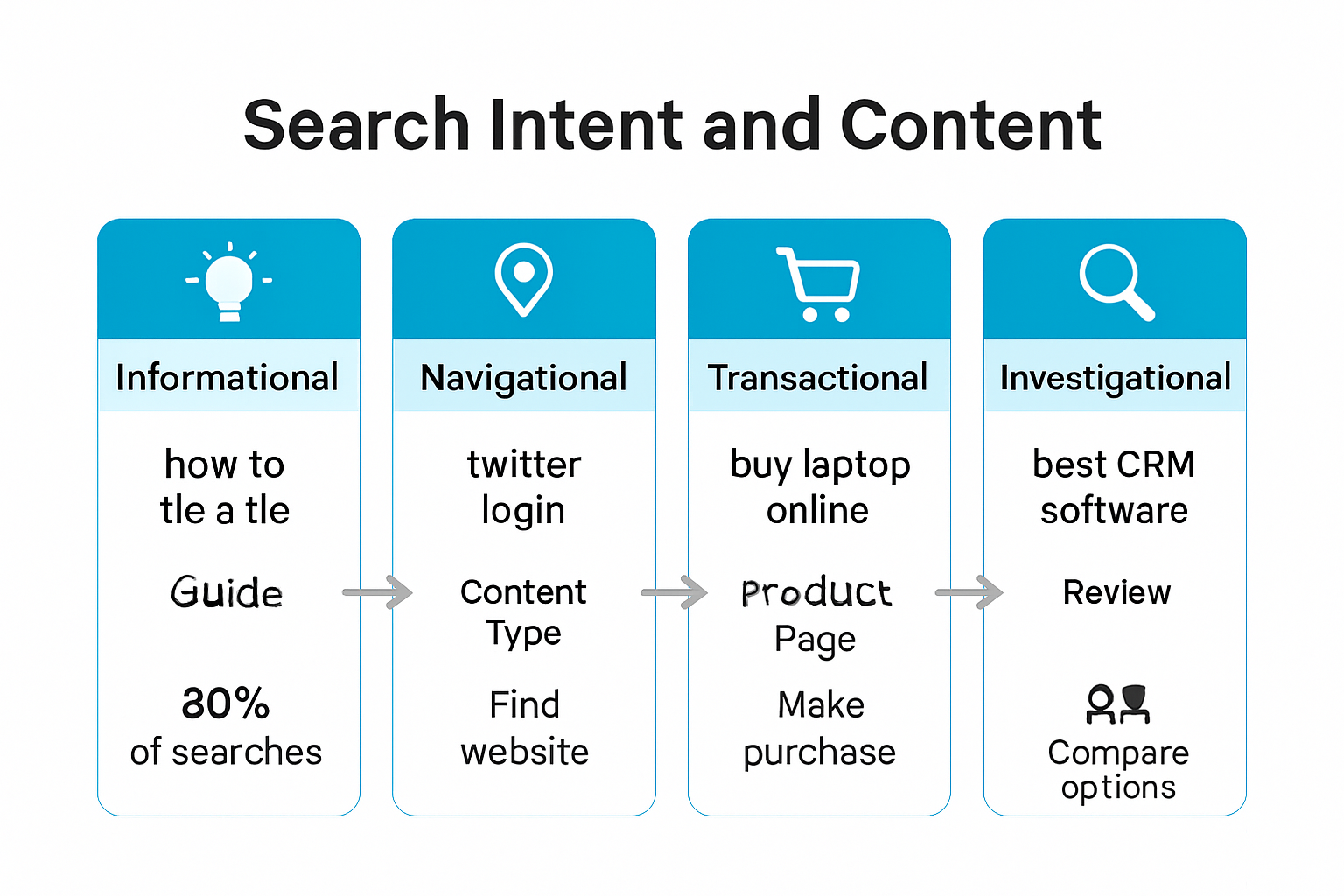Content gaps can quietly drain the potential of your website and leave traffic on the table that could be yours. But most teams miss them because they never do a full audit or map user intent. One overlooked step changes everything: studies show that websites updating and expanding underperforming pages can see organic traffic climb by over 30 percent. The path to better rankings and more clicks starts with spotting—and closing—those silent gaps.
Table of Contents
- Step 1: Analyze Your Existing Content Strategy
- Step 2: Conduct Keyword Research For Missing Topics
- Step 3: Evaluate Competitor Content And Strategies
- Step 4: Identify User Intent And Content Alignment
- Step 5: Create A Content Plan To Fill Gaps
- Step 6: Monitor Performance And Adjust Strategies
Quick Summary
| Key Point | Explanation |
|---|---|
| 1. Conduct a content audit | Review existing content to find gaps and weaknesses in your SEO strategy. |
| 2. Perform keyword research | Identify missing topics through keyword analysis to align with user search intent. |
| 3. Analyze competitor content | Review top competitors to discover content gaps and opportunities for your brand. |
| 4. Understand user intent | Classify search queries to align your content with what users truly want. |
| 5. Develop a content plan | Create a structured roadmap to fill identified content gaps strategically. |
Step 1: Analyze Your Existing Content Strategy
Identifying content gaps starts with a comprehensive audit of your current content strategy. This critical first step helps you understand your existing content landscape, revealing potential opportunities and weaknesses in your SEO approach. By systematically examining your content, you can pinpoint areas where your website lacks comprehensive coverage or fails to address user search intent.
Begin by gathering all your existing content assets into a centralized spreadsheet or content management system. Organize your content by key categories, including blog posts, product pages, guides, and resource materials. You will want to track each piece of content with specific details such as publication date, target keywords, page URL, and current performance metrics like organic traffic, engagement rates, and search rankings.
Next, use powerful analytics tools to dig deeper into your content performance. Learn more about strategic content optimization by examining how each piece of content contributes to your overall SEO strategy. Google Analytics and Google Search Console provide invaluable insights into user behavior, search queries, and content effectiveness. Pay special attention to metrics like:
- Average time on page
- Bounce rates
- Organic search impressions
- Click through rates
- Conversion rates
As you analyze these metrics, look for patterns and anomalies. Some content might perform exceptionally well, while others attract minimal traffic. These variations can indicate potential content gaps or opportunities for improvement. Consider the search intent behind underperforming pages. Are they addressing user questions comprehensively? Do they provide clear, actionable information? Understanding these nuances will help you strategically plan your content improvements.
To help you keep track of essential analytics and research platforms mentioned in this guide, here’s a summary of key tools and their specific purposes for content gap analysis:
| Tool | Purpose |
|---|---|
| Google Analytics | Analyze user behavior and track content performance |
| Google Search Console | Identify search queries, impressions, and technical SEO data |
| SEMrush | Conduct keyword and competitor research |
| Ahrefs | Discover keyword ideas, backlink data, and competitor content |
| Moz | Evaluate competitor domain authority and content strength |
| Google Keyword Planner | Explore keyword search volumes and trends |
| Reddit, Quora | Research real user questions and emerging topics |
To verify you have completed this step effectively, ensure your content audit spreadsheet is complete, you have identified at least three potential content gap areas, and you have clear performance data for each existing content piece. The goal is not just to collect data, but to transform those insights into a strategic roadmap for content enhancement.
Step 2: Conduct Keyword Research for Missing Topics
Keyword research is the strategic foundation for uncovering content gaps and understanding what your audience truly seeks online. This step transforms your content strategy from guesswork to a precise, data-driven approach that connects directly with user search intent. By systematically exploring keyword opportunities, you will reveal topics your current content might be overlooking.
Start by leveraging multiple keyword research tools to generate a comprehensive view of potential content opportunities. Google Keyword Planner, SEMrush, and Ahrefs offer robust features for discovering related search terms and understanding user search behavior. Discover advanced keyword optimization techniques that can dramatically improve your content strategy. Pay close attention to long-tail keywords, which often represent specific user questions or niche topics that larger websites might ignore.
Expand your keyword exploration by examining several critical sources. Review the “People Also Ask” sections in Google search results, which provide direct insights into related queries users are searching. Analyze discussion forums like Reddit and Quora where users openly share their questions and challenges. Check industry-specific platforms and community boards to understand emerging topics and knowledge gaps in your field.
Compile your keyword research into a structured spreadsheet that captures essential details. Organize your findings with columns tracking search volume, keyword difficulty, current content coverage, and potential content type (blog post, guide, tutorial). Prioritize keywords that demonstrate:
- Significant search volume
- Moderate competition
- Clear alignment with your brand expertise
- Potential for creating comprehensive, valuable content
To verify successful keyword research, ensure you have identified at least 15-20 potential content topics that are currently missing from your website. These topics should represent genuine user interests and have sufficient search demand to justify content creation. The goal is not just quantity, but strategic potential for driving organic traffic and providing genuine value to your audience.
Step 3: Evaluate Competitor Content and Strategies
Competitor content analysis is a strategic approach to understanding the content landscape in your industry and identifying potential gaps your website can fill. This step goes beyond simple observation, transforming competitor insights into actionable content opportunities that can differentiate your brand and attract more organic traffic.
Begin by identifying your top industry competitors through a combination of search engine rankings, domain authority, and relevance to your target audience. Explore advanced content optimization techniques that can help you stay ahead of competitive content strategies. Use tools like SEMrush, Ahrefs, or Moz to conduct a comprehensive competitive analysis. These platforms provide detailed insights into your competitors’ content performance, revealing topics they cover extensively and areas where their coverage might be lacking.
Carefully examine each competitor’s content library, paying close attention to their blog posts, guides, whitepapers, and resource pages. Look for patterns in their content approach: What topics do they consistently cover? What unique angles do they take? More importantly, identify the topics they have not addressed or only superficially covered. These content gaps represent prime opportunities for you to create comprehensive, high-quality content that provides more value to your target audience.
Develop a systematic approach to documenting your competitive content analysis. Create a detailed spreadsheet that tracks:
- Competitor website URLs
- Content topics they cover
- Content types and formats
- Perceived content strengths and weaknesses
- Potential content gaps
To verify the success of your competitor analysis, ensure you have mapped out at least 10-15 potential content topics that are either missing from competitor websites or can be significantly improved upon. The goal is not to copy competitor content, but to understand the existing content ecosystem and strategically position your own content to provide unique, valuable insights that set you apart from the competition.
Step 4: Identify User Intent and Content Alignment
Understanding user intent is the critical bridge between content creation and audience satisfaction. This step transforms your content strategy from guesswork to a precision-targeted approach that directly addresses what users are genuinely seeking when they enter search queries. By deeply analyzing the motivations behind search behaviors, you can create content that not only ranks well but truly resonates with your audience.
Begin by categorizing search queries into their fundamental intent types: informational, navigational, transactional, and investigational. This nuanced approach allows you to map your content precisely to user expectations. Learn more about strategic content optimization that aligns perfectly with user search behaviors. Examine each keyword from your previous research through this intent lens. An informational query like “how to fix a leaky faucet” requires a step-by-step tutorial, while a transactional query such as “best plumbing tools” demands a comparative review with purchasing recommendations.
Utilize advanced analytics tools to dive deeper into user behavior. Google Search Console and Google Analytics provide invaluable insights into how users interact with your current content. Look beyond surface-level metrics and examine nuanced data points like time on page, bounce rates, and user flow. These indicators reveal whether your existing content genuinely satisfies user intent or falls short of expectations. Pay special attention to the keywords that bring users to your site and analyze the alignment between their search query and the content they ultimately consume.
Develop a comprehensive intent mapping strategy that tracks:
- Keyword intent classification
- Current content alignment percentage
- Potential content improvement areas
- User engagement metrics
To verify successful user intent analysis, ensure you have identified specific content gaps where your current materials do not fully address user search motivations. The goal is to create a strategic roadmap that transforms your content from generic information to precisely targeted, user-centric resources that answer real questions and solve genuine problems.
Below is a simple checklist table to help you verify completion for each step in the content gap analysis process. Use this table to ensure you don’t miss any critical actions as you work through the guide:
| Step | Completion Criteria |
|---|---|
| Analyze Existing Content Strategy | Content audit spreadsheet complete; 3+ gap areas identified; performance data documented |
| Conduct Keyword Research | 15-20 missing topics with search demand identified |
| Evaluate Competitor Content | 10-15 improvement or missing topics mapped |
| Align Content With User Intent | Gaps where intent is not met are clearly outlined |
| Create Content Plan | 10-15 prioritized topics and publishing workflow ready |
| Monitor Performance & Adjust | System for review, metrics, and improvement established |

Step 5: Create a Content Plan to Fill Gaps
Transforming your content gap analysis into a strategic action plan is the critical bridge between insight and implementation. This step converts your research into a structured roadmap that systematically addresses the missing elements in your content ecosystem, ensuring a comprehensive and targeted approach to filling identified gaps.
Prioritize your content creation efforts by developing a detailed content matrix that ranks potential topics based on strategic importance. Explore advanced content optimization strategies that can help refine your content planning process. Assign weighted scores to each potential content piece considering factors like search volume, keyword difficulty, user intent alignment, and potential business impact. This approach ensures you are not just creating content, but strategically investing in materials that will drive meaningful organic traffic and user engagement.
Establish a clear content creation workflow that outlines specific responsibilities, timelines, and quality standards. Determine the resources required for each content piece, including subject matter experts, writers, editors, and graphic designers. Create a content calendar that schedules topic development, research, writing, editing, and publication dates. This structured approach helps maintain consistency and ensures that your content gap filling strategy remains methodical and sustainable.
Develop a comprehensive tracking mechanism for your content plan that includes:
- Proposed content topics
- Assigned content creators
- Estimated publication dates
- Required research and resources
- Target keywords and search intent
- Projected content performance metrics
To verify the success of your content plan, ensure you have a fully populated content matrix with at least 10-15 prioritized topics that directly address the content gaps identified in previous steps. The goal is to create a living document that not only guides your content creation but also allows for ongoing refinement and optimization based on performance data and evolving user needs.

Step 6: Monitor Performance and Adjust Strategies
Continuous performance monitoring is the cornerstone of a dynamic and responsive content strategy. This final step transforms your content gap analysis from a static document into a living, adaptive approach that evolves with your audience’s changing needs and search behavior. By implementing a robust tracking and adjustment mechanism, you ensure your content remains relevant, competitive, and aligned with your SEO objectives.
Set up comprehensive tracking dashboards using advanced analytics tools that provide granular insights into content performance. Discover expert performance tracking techniques that can help you make data-driven content decisions. Google Analytics, Google Search Console, and specialized SEO platforms like SEMrush offer powerful metrics that go beyond surface-level statistics. Focus on key performance indicators such as organic traffic, average time on page, bounce rates, conversion rates, and keyword rankings for each piece of content you have created to fill identified gaps.
Establish a regular review cycle for your content performance, ideally on a quarterly basis. During these reviews, conduct a detailed analysis of how your new content is performing compared to your initial expectations. Look for patterns in user engagement, search engine rankings, and overall content effectiveness. Be prepared to make strategic adjustments, which might include refining existing content, updating keyword targeting, improving internal linking, or completely reimagining pieces that are not meeting performance benchmarks.
Create a systematic approach to performance tracking that includes:
- Quarterly content performance review dates
- Specific metrics for evaluation
- Threshold triggers for content modification
- Responsible team members for analysis and updates
- Documented adjustment strategies
To verify the success of your monitoring process, ensure you have a repeatable system that provides actionable insights and demonstrates continuous improvement in your content strategy. The ultimate goal is to develop an agile, responsive approach that keeps your content consistently aligned with user needs and search engine expectations.
Ready to Eliminate Your Content Gaps for Explosive SEO Growth?
You have just learned how analyzing your content and filling gaps reveals missed opportunities for organic traffic and real business impact. But even with a precise content audit, unseen keyword cannibalization can block your hard-earned SEO results. If your website struggles with overlapping keywords or unclear content targeting, those blind spots undermine all your efforts. Ranking higher starts with full clarity on your site structure and keyword use.
Take your strategy to the next level with the #1 tool trusted by SEO consultants and agencies. Rankaligner gives you the power to spot keyword cannibalization and uncover the issues holding your site back. Secure your advantage before your competitors do. Try our top-rated cannibalization solution today and start driving stronger results from every piece of content. Transform your insights into action now—visit our website to make your improvements deliver real SEO wins.
Frequently Asked Questions
How can I analyze my existing content strategy to find gaps?
To analyze your existing content strategy, conduct a comprehensive audit of your current content. Gather all your content into a centralized document, tracking details like publication date, target keywords, and performance metrics. This will help identify areas lacking comprehensive coverage or failing to meet user search intent.
What tools can I use for keyword research to discover content gaps?
You can utilize tools such as Google Keyword Planner, SEMrush, and Ahrefs to conduct keyword research. These tools help uncover related search terms and understand user behavior, allowing you to identify potential topics your content may be missing.
How can I evaluate competitor content for content gaps?
Start by identifying your top industry competitors through search rankings and relevance, then analyze their content for coverage and quality. Look for topics they consistently address and those they overlook, as these represent opportunities for you to create valuable, unique content.
How do I ensure that my content aligns with user intent?
Categorize search queries into intent types—informational, navigational, transactional, and investigational. Analyze keywords from your research through this lens to ensure that the content you create accurately addresses user questions and needs, enhancing engagement and satisfaction.
Recommended
- 15 Winning Hacks to Avoid Keyword Cannibalization Like a Pro
- The Final Guide to Content Cannibalization in SEO (& How to Avoid)
- 10 Keyword Cannibalization Mistakes That Are Killing Your SEO
- SEO Audit Checklist: Key Steps for Better Rankings – Rank Aligner – Your Ultimate Keyword Cannibalization Problem Solver

